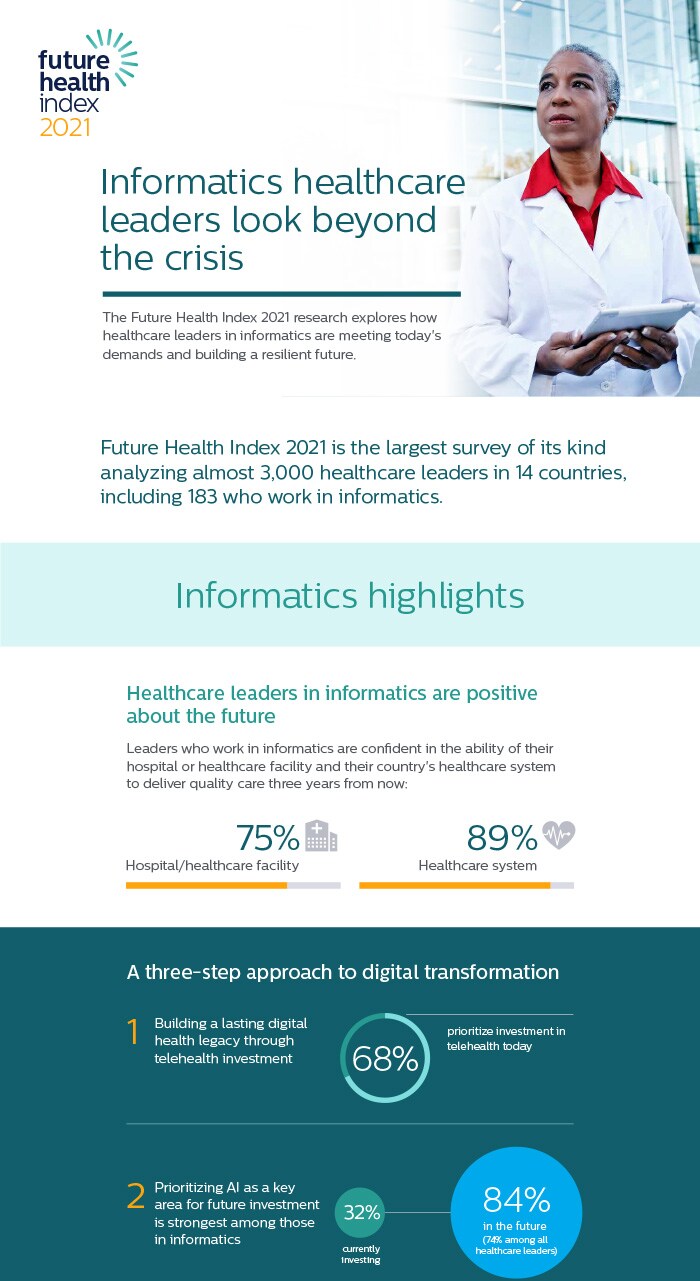Amid the COVID-19 pandemic, accurate timely data has proved pivotal in responding to fast changing on-the-ground situations. It is therefore no surprise that the 2021 Future Health Index - a global survey of healthcare professionals which this year explored how healthcare leaders are meeting today's demands and building resilience into the system - revealed that healthcare leaders in informatics are positive about the future, with telehealth and artificial intelligence (AI) high on their investment list. However, responding to the immediate needs of the pandemic is still widely regarded as one of the main obstacles to planning for the future. Asked about their priorities, around two-thirds (68%) of the informatics healthcare leaders surveyed indicated that preparing for future crises was high on their list, almost half (48%) highlighted the need to shift towards remote or virtual care, and around a fifth (21%) indicated the need for improving the technology infrastructure in their hospital or healthcare facility. At the same time, they have not lost sight of the role of healthcare informatics in bringing about the shift to value-based care, with only 14% of respondents stating that the COVID-19 pandemic had deprioritized this objective. Nevertheless, value-based care still appears to be in the ‘early adopter’ stage. Few (11%) of the informatics healthcare leaders surveyed reported that their facilities were already practicing value-based care and only 15% reported that they are currently pursuing it. That does not mean they don’t recognize its benefits: almost half (47%) said that they plan to implement value-based care in the future.
So much for the future, but what are informatics healthcare leaders focused on right now?
The answer would appear to be telehealth, which takes two forms. Healthcare professional-to-healthcare professional telehealth encompasses activities such as consulting virtually with other healthcare professionals, sharing images and recommending treatment plans, while healthcare professional-to-patient telehealth, covers consultation via video calls or patient portals. Currently around two-thirds (68%) of informatics healthcare leaders are investing in any form of telehealth; 56% for healthcare professional-to-healthcare professional telehealth and 43% for healthcare professional-to-patient telehealth (43%). Unlike the early adopter phase for value-based care, it appears that telehealth is already going mainstream, representing a foundation for healthcare digitalization that is being invested in now. Potentially because they have invested in telehealth heavily over the past few years, around a third (31%) of the informatics healthcare leaders surveyed said they expect to invest in telehealth technology three years from now. Having laid the foundations for digitalization, it appears their attention will soon turn to predictive healthcare technologies, such as AI. Almost a third (32%) are currently investing in some form of AI and well over three-quarters (84%) say they want to invest in the technology within the next three years. “The AI capabilities healthcare informatics leaders expect to invest in are for both administrative purposes such as operational efficiency optimization, as well as clinical tasks such as diagnosis, outcome prediction, and clinical decision support,” said Calum Cunningham, General Manager of Enterprise Diagnostic Informatics at Philips. “Nevertheless, they also highlight several challenges that need to be overcome, including staff inexperience with new technology, data interoperability, data privacy and security, and reimbursement models.”
Perennial issues around interoperability and data security remain biggest pain points
While technology provides many more opportunities, it also contributes to the growing complexity of the health IT landscape with even more disparate processes that must be maintained, supported, and standardized across an entire enterprise environment. More so than the average healthcare leader across the 14 countries surveyed, those working in informatics say difficulties with data management (53% vs. 44% 14-country average) and a lack of interoperability or data standards across technological systems and platforms (45% vs. 37% 14-country average) are the biggest barriers to digital health technology adoption in their hospital or healthcare facility. While ensuring data security and privacy is a priority currently for around a quarter of informatics healthcare leaders (23%), this figure will rise in the future to 33% three years from now. “Many of these inefficient processes can be avoided by improving workflows or leveraging technology – although that can be easier said than done. One approach helping healthcare executives and department heads move their organizations forward through technology is the use of adoption and maturity models, which are designed to help organizations progressively measure and advance analytics capabilities to improve healthcare delivery,” Cunningham added. “One example is the Digital Imaging Adoption Model (DIAM), which provides guidance for imaging and IT experts to identify and adopt the right digital strategy to improve health outcomes for patients.”
Building a sustainable healthcare future
Building resilience and sustainability into healthcare systems is also top of mind, with an increasing proportion of routine care expected to be delivered in out-of-hospital settings such as ambulatory primary care centers, pharmacies, and people’s homes. In addition, almost two-thirds (65%) said that in three years’ time they would be implementing sustainability practices in their healthcare facilities – such as environmentally conscious sourcing or recycling - a major increase on those (8%) who were currently prioritizing sustainability. Moving a portion of care outside of hospital walls can help to reduce hospital and healthcare facility CO2 emissions as patients expend less energy traveling to a traditional point of care. Overall, informatics healthcare leaders were optimistic about the future. Confidence in the ability of the healthcare system in their country to deliver quality care in the future is high, as well as from their specific hospital or healthcare facility (89% and 75% respectively). One belief around a third of informatics healthcare leaders (38%) share with Philips is that prioritizing strategic partnerships/collaborations is an action their hospital or healthcare facility must take to successfully implement digital health technologies. With roles and responsibilities that typically span enterprise-wide initiatives and involve third-party organizations such as health technology companies and cloud service providers, perhaps that’s not so surprising. Philips will showcase its latest connected, secure and scalable informatics solutions at the annual HIMSS21 Global Health Conference & Exhibition, August 9-13. Attendees can explore the Philips Health Informatics Experience to view in-depth solution demos of the latest innovations from Philips. The experience will remain open to visitors until spring 2022. For more information on Philips’ full portfolio of informatics solutions being showcased at the HIMSS21 Global Health Conference & Exhibition, please visit www.philips.com/himss and follow @PhilipsLiveFrom for #HIMSS21 updates throughout the event.
Share on social media
Topics
Contact

Kathy O'Reilly
Philips Global Press Office Tel.: +1 978-221-8919
You are about to visit a Philips global content page
Continue

